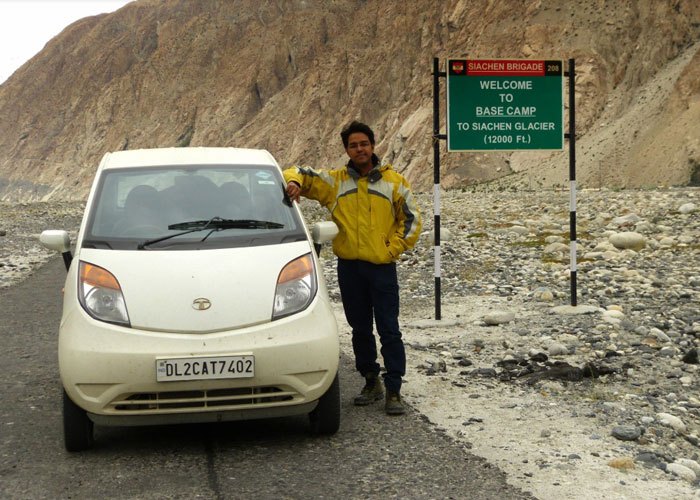World's Cheapest Stripper Bites the Dust; Disinterested Public Barely Mourns

While our Ace of Base series delights in revealing just how bargain basement a mainstream vehicle can get, none of those rides hold a candle to the spartan purgatory that was the Tata Nano.
Billed as the world’s cheapest car upon its release in 2008, the Indian-market four-door was tailor-made to lure that country’s growing market of would-be vehicle owners off motorcycles and into a car with two cylinders, 37 horsepower, and a rear hatch that didn’t open.
Not unexpectedly, the vehicle quickly developed a stigma.
Cheap? Yes it was. Oh so cheap. Roughly $2,000 a decade ago, but now $3,500. New features, like a working hatch, found their way into the Nano over the ensuing years. And how about that automated manual transmission? No more four-speed stick for some buyers…
As the country’s GDP grew, and along with it the Indian middle class, Nano sales rose accordingly, but not by as much as Tata Motors had hoped. Initially pegging demand at a quarter million vehicles per year, Tata saw the Nano’s sales peak at just under 75,000 in the financial year 2011-2012. In FY 2016-2017, just 7,591 vehicles rolled off lots.
Frankly, India’s “people’s car” was just too cheap, too bare bones, and not aspirational enough. Safety on India’s notoriously congested and relatively lawless highways was another concern. Germany once crash tested the Nano and found it warranted zero stars.
As Bloomberg reports, the market has spoken. Tata built a single Nano in June, despite new car sales in the world’s second most populous country growing by 38 percent. The automaker, parent company of Jaguar Land Rover, said the Nano in its “present form cannot continue beyond 2019.”
However, it seems the company still feels some sort of future could exist for the little runabout. Tata told Bloomberg that the Nano “may need fresh investments to survive” — an understatement, given the model’s nonexistent sales.
[Images: Tata Motors]

More by Steph Willems
Latest Car Reviews
Read moreLatest Product Reviews
Read moreRecent Comments
- Honda1 Unions were needed back in the early days, not needed know. There are plenty of rules and regulations and government agencies that keep companies in line. It's just a money grad and nothing more. Fain is a punk!
- 1995 SC If the necessary number of employees vote to unionize then yes, they should be unionized. That's how it works.
- Sobhuza Trooper That Dave Thomas fella sounds like the kind of twit who is oh-so-quick to tell us how easy and fun the bus is for any and all of your personal transportation needs. The time to get to and from the bus stop is never a concern. The time waiting for the bus is never a concern. The time waiting for a connection (if there is one) is never a concern. The weather is never a concern. Whatever you might be carrying or intend to purchase is never a concern. Nope, Boo Cars! Yeah Buses! Buses rule!Needless to say, these twits don't actual take the damn bus.
- MaintenanceCosts Nobody here seems to acknowledge that there are multiple use cases for cars.Some people spend all their time driving all over the country and need every mile and minute of time savings. ICE cars are better for them right now.Some people only drive locally and fly when they travel. For them, there's probably a range number that works, and they don't really need more. For the uses for which we use our EV, that would be around 150 miles. The other thing about a low range requirement is it can make 120V charging viable. If you don't drive more than an average of about 40 miles/day, you can probably get enough electrons through a wall outlet. We spent over two years charging our Bolt only through 120V, while our house was getting rebuilt, and never had an issue.Those are extremes. There are all sorts of use cases in between, which probably represent the majority of drivers. For some users, what's needed is more range. But I think for most users, what's needed is better charging. Retrofit apartment garages like Tim's with 240V outlets at every spot. Install more L3 chargers in supermarket parking lots and alongside gas stations. Make chargers that work like Tesla Superchargers as ubiquitous as gas stations, and EV charging will not be an issue for most users.
- MaintenanceCosts I don't have an opinion on whether any one plant unionizing is the right answer, but the employees sure need to have the right to organize. Unions or the credible threat of unionization are the only thing, history has proven, that can keep employers honest. Without it, we've seen over and over, the employers have complete power over the workers and feel free to exploit the workers however they see fit. (And don't tell me "oh, the workers can just leave" - in an oligopolistic industry, working conditions quickly converge, and there's not another employer right around the corner.)
































Comments
Join the conversation
I suggest you look up "disinterested" vs "uninterested". Yes, they are two wildly different things. No, a millenial declaring otherwise out of thin air doesn't change that.
Part of the Nano's problem was Tata's own Magic Iris commercial vehicle. It sells for about the same price as the Nano, has a 12.5 hp diesel engine, and can carry more people. It also doesn't have the stigma of being the world's cheapest car. Also, Ratan Tata underestimated the aspirations of Indians to whom he hoped to sell the Nano.